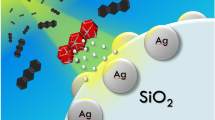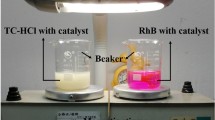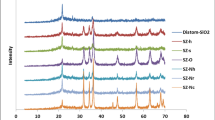Abstract
In this contribution, the effect of physical immobilization of methylene blue (MB) into silica nanocomposites was investigated on the conversion and selectivity of the photooxygenation of anthracene and dihydroartemisinic acid (DHAA). Physically immobilized photocatalysts were synthesized through a developed Stöber method and were thoroughly characterized by UV–Vis, FTIR, XRD, XPS, SEM, TEM, HR-TEM, BET-BJH, and EDX analyses. Based on the TEM and UV–Vis results, it was determined that enhancement of the MB concentration as an organocatalyst for the Stöber reaction led to an increase in the size of the nanoparticles from 54 to 183 nm and a 21 nm blue shift in their UV–Vis spectra. Moreover, utilizing an immobilized MB as a photocatalyst for photooxygenation reactions under visible light led to a remarkable enhancement of 9% (i.e., from 89 to 98%) in the reaction conversion of anthracene photooxygenation compared to those using the same amount of homogenous MB. Nonetheless, a 5% reduction (i.e., 83 to 78%) in the selectivity of photooxygenation of DHAA was observed. These behaviors were rationalized through the nanoconfinement effects of pores with a narrow size distribution of 3.1 nm obtained through the HR-TEM and BET-BJH analyses, which led to a controlled aggregation of the MB molecules. Deep neural networks (DNNs) were applied to accurately predict the UV–Vis spectra and aggregation of the MB molecules. The results from time-dependent density functional theory (TD-DFT) calculations suggested that aggregation of the MB led to decreasing in intersystem crossing energy gap; hence, an increase in the 1O2 generation became possible. Finally, the finite element method (FEM) simulation revealed a 300 nm penetration depth of 1O2 around synthesized photocatalysts.
Graphical abstract












Similar content being viewed by others
Data availability
More data used to support the findings of this study were included within the article and supporting information.
References
Li C, Lin F, Sun W et al (2018) Self-assembled Rose Bengal-exopolysaccharide nanoparticles for improved photodynamic inactivation of bacteria by enhancing singlet oxygen generation directly in the solution. ACS Appl Mater Interfaces 10:16715–16722. https://doi.org/10.1021/acsami.8b01545
Tsay JM, Trzoss M, Shi L et al (2007) Singlet oxygen production by peptide-coated quantum dot− photosensitizer conjugates. J Am Chem Soc 129:6865–6871
Shiragami T, Makise RI, Inokuchi Y et al (2004) Efficient photocatalytic oxidation of cycloalkenes by dihydroxo(tetraphenylporphyrinato)-antimony supported on silica gel under visible light irradiation. Chem Lett 33:736–737. https://doi.org/10.1246/cl.2004.736
Martins Estevão B, Miletto I, Marchese L, Gianotti E (2016) Optimized Rhodamine B labeled mesoporous silica nanoparticles as fluorescent scaffolds for the immobilization of photosensitizers: a theranostic platform for optical imaging and photodynamic therapy. Phys Chem Chem Phys 18:9042–9052. https://doi.org/10.1039/c6cp00906a
Mesquita MQ, Menezes JCJMDS, Pires SMG et al (2014) Pyrrolidine-fused chlorin photosensitizer immobilized on solid supports for the photoinactivation of Gram negative bacteria. Dye Pigment 110:123–133. https://doi.org/10.1016/j.dyepig.2014.04.025
Barata JFB, Daniel-Da-Silva AL, Neves MGPMS et al (2013) Corrole-silica hybrid particles: Synthesis and effects on singlet oxygen generation. RSC Adv 3:274–280. https://doi.org/10.1039/c2ra22133k
Irgibayeva I, Mantel A, Barashkov N et al (2021) Study of the effect of the introduction of Tris(bipyridine)ruthenium(II) chloride into silicon dioxide particles by spectrofluorometry methods. Spectrochim Acta - Part A Mol Biomol Spectrosc 246:119007. https://doi.org/10.1016/j.saa.2020.119007
Kim H, Kim W, MacKeyev Y et al (2012) Selective oxidative degradation of organic pollutants by singlet oxygen-mediated photosensitization: tin porphyrin versus C60 aminofullerene systems. Environ Sci Technol 46:9606–9613. https://doi.org/10.1021/es301775k
Semeraro P, Syrgiannis Z, Bettini S et al (2019) Singlet oxygen photo-production by perylene bisimide derivative Langmuir-Schaefer films for photodynamic therapy applications. J Colloid Interface Sci 553:390–401. https://doi.org/10.1016/j.jcis.2019.06.037
Montaseri H, Kruger CA, Abrahamse H (2020) Recent advances in porphyrin-based inorganic nanoparticles for cancer treatment. Int J Mol Sci 21:3358. https://doi.org/10.3390/ijms21093358
Chen J, Fan T, **e Z et al (2020) Advances in nanomaterials for photodynamic therapy applications: Status and challenges. Biomaterials 237:119827. https://doi.org/10.1016/j.biomaterials.2020.119827
Barona-Castaño JC, Carmona-Vargas CC, Brocksom TJ et al (2016) Porphyrins as catalysts in scalable organic reactions. Molecules 21:310. https://doi.org/10.3390/molecules21030310
Wang S, Gao R, Zhou F, Selke M (2004) Nanomaterials and singlet oxygen photosensitizers: Potential applications in photodynamic therapy. J Mater Chem 487–493.https://doi.org/10.1039/b311429e
DeRosa MC, Crutchley RJ (2002) Photosensitized singlet oxygen and its applications. Coord Chem Rev 233–234:351–371. https://doi.org/10.1016/S0010-8545(02)00034-6
Gianotti E, Martins Estevão B, Cucinotta F et al (2014) An efficient rose bengal based nanoplatform for photodynamic therapy. Chem - A Eur J 20:10921–10925. https://doi.org/10.1002/chem.201404296
Mendoza C, Emmanuel N, Páez CA et al (2018) Improving continuous flow singlet oxygen photooxygenation reactions with functionalized mesoporous silica nanoparticles. ChemPhotoChem 2:890–897. https://doi.org/10.1002/cptc.201800148
Chen XF, Ng DKP (2021) β-Cyclodextrin-conjugated phthalocyanines as water-soluble and recyclable sensitisers for photocatalytic applications. Chem Commun 57:3567–3570
Byun J, Hong Y, Zhang KAI (2021) Beyond the batch: process and material design of polymeric photocatalysts for flow photochemistry. Chem Catal 771–781.https://doi.org/10.1016/j.checat.2021.08.003
Zhou L, Ge X, Zhou J et al (2015) Multicolor imaging and the anticancer effect of a bifunctional silica nanosystem based on the complex of graphene quantum dots and hypocrellin A. Chem Commun 51:421–424. https://doi.org/10.1039/c4cc06968d
Panwar N, Soehartono AM, Chan KK et al (2019) Nanocarbons for biology and medicine: sensing, imaging, and drug delivery. Chem Rev 119:9559–9656. https://doi.org/10.1021/acs.chemrev.9b00099
Wang J, Zhong Y, Wang X et al (2017) PH-dependent assembly of porphyrin-silica nanocomposites and their application in targeted photodynamic therapy. Nano Lett 17:6916–6921. https://doi.org/10.1021/acs.nanolett.7b03310
Martins Estevão B, Cucinotta F, Hioka N et al (2015) Rose Bengal incorporated in mesostructured silica nanoparticles: structural characterization, theoretical modeling and singlet oxygen delivery. Phys Chem Chem Phys 17:26804–26812. https://doi.org/10.1039/c5cp03564c
Pineiro M, Ribeiro SM, Serra AC (2010) The influence of the support on the singlet oxygen quantum yields of porphyrin supported photosensitizers. ARKIVOC 2010:51–63. https://doi.org/10.3998/ark.5550190.0011.506
Mendoza C, Désert A, Khrouz L et al (2019) Heterogeneous singlet oxygen generation: in-operando visible light EPR spectroscopy. Environ Sci Pollut Res 0–5.https://doi.org/10.1007/s11356-019-04763-5
Tambosco B, Segura K, Seyrig C et al (2018) Outer-sphere effects in visible-light photochemical oxidations with immobilized and recyclable ruthenium bipyridyl salts. ACS Catal 8:4383–4389. https://doi.org/10.1021/acscatal.8b00890
Nakamura T, Son A, Umehara Y et al (2016) Confined singlet oxygen in mesoporous silica nanoparticles: selective photochemical oxidation of small molecules in living cells. Bioconjug Chem 27:1058–1066. https://doi.org/10.1021/acs.bioconjchem.6b00061
Kitajima N, Umehara Y, Son A et al (2018) Confinement of singlet oxygen generated from ruthenium complex-based oxygen sensor in the pores of mesoporous silica nanoparticles. Bioconjug Chem 29:4168–4175. https://doi.org/10.1021/acs.bioconjchem.8b00811
Gellé A, Price GD, Voisard F et al (2021) Enhancing singlet oxygen photocatalysis with plasmonic nanoparticles. ACS Appl Mater Interfaces 13:35606–35616. https://doi.org/10.1021/acsami.1c05892
Sun C, Chen T, Huang Q et al (2021) Selective production of singlet oxygen from zinc-etching hierarchically porous biochar for sulfamethoxazole degradation ☆. Environ Pollut 290:117991. https://doi.org/10.1016/j.envpol.2021.117991
Hynek J, Payne DT, Chahal MK et al (2021) Enhancement of singlet oxygen generation based on incorporation of oxoporphyrinogen ( OxP ) into microporous solids. Mater Today Chem 21:100534. https://doi.org/10.1016/j.mtchem.2021.100534
Zhao S, Zhao X (2019) Insights into the role of singlet oxygen in the photocatalytic hydrogen peroxide production over polyoxometalates-derived metal oxides incorporated into graphitic carbon nitride framework. Appl Catal B Environ 250:408–418. https://doi.org/10.1016/j.apcatb.2019.02.031
Gu Y, Xu T, Zhu Z et al (2021) Atomic-scale tailoring and molecular-level tracking of oxygen-containing tungsten single-atom catalysts with enhanced singlet oxygen generation. ACS Appl Mater Interfaces 1–10.https://doi.org/10.1021/acsami.1c09016
Wang J, Zhang X, Liu Y et al (2021) Enhanced singlet oxygen production over a photocatalytic stable metal organic framework composed of porphyrin and Ag. J Colloid Interface Sci 602:300–306. https://doi.org/10.1016/j.jcis.2021.05.087
Shelemanov AA, Evstropiev SK, Karavaeva AV, et al (2021) Enhanced singlet oxygen photogeneration by bactericidal ZnO–MgO–Ag nanocomposites. Mater Chem Phys 125204.https://doi.org/10.1016/j.matchemphys.2021.125204
Hu Y, Huang Y, Wang X et al (2018) Insight into singlet oxygen generation from metastable lattice of Treated-NaBiO3: a mechanism study. Mater Chem Phys 213:389–399. https://doi.org/10.1016/j.matchemphys.2018.03.079
Tamtaji M, Kazemeini M (2020) Preparation of a novel nano-photosensitizer utilized for the photooxygenation of an organic material: a leap towards more efficient production of Artemisinin medicine. In: 8 th International Conference on Nanostructures (ICNS8). p 710
Yang Z, Qian J, Yu A, Pan B (2019) Singlet oxygen mediated iron-based Fenton-like catalysis under nanoconfinement.https://doi.org/10.1073/pnas.1819382116
Terra JCS, Desgranges A, Monnereau C et al (2020) Photocatalysis meets magnetism: designing magnetically recoverable supports for visible-light photocatalysis. ACS Appl Mater Interfaces 12:24895–24904. https://doi.org/10.1021/acsami.0c06126
Tamtaji M, Tyagi A, You CY et al (2021) Singlet oxygen photosensitization using graphene-based structures and immobilized dyes: a review. ACS Appl Nano Mater 4:7563–7586. https://doi.org/10.1021/acsanm.1c01436
Tamtaji M, Kazemeini M, Tyagi A, Roxas AP (2022) Selective photooxygenation of dihydroartemisinic acid in a reusable microreactor with physically immobilized photocatalysts. Mater Res Bull 145:111540. https://doi.org/10.1016/J.MATERRESBULL.2021.111540
Badran HM, Eid KM, Ammar HY (2021) DFT and TD-DFT studies of halogens adsorption on cobalt-doped porphyrin: effect of the external electric field. Results Phys 23:103964. https://doi.org/10.1016/j.rinp.2021.103964
Wu W, Zhang Q, Wang X et al (2017) Enhancing selective photooxidation through Co−Nx-doped carbon materials as singlet oxygen photosensitizers. ACS Catal 7:7267–7273. https://doi.org/10.1021/acscatal.7b01671
De Queiroz TB, De Figueroa ER, Coutinho-Neto MD et al (2021) First principles theoretical spectroscopy of methylene blue: between limitations of time-dependent density functional theory approximations and its realistic description in the solvent. J Chem Phys 154:.https://doi.org/10.1063/5.0029727
Tamtaji M, Kazemeini M (2022) Utilizing graphene oxide/gold/methylene blue ternary nanocomposite as a visible light photocatalyst for a plasmon-enhanced singlet oxygen generation. React Kinet Mech Catal 1–15. https://doi.org/10.1007/s11144-022-02271-1
Sasaki N, Mabesoone MFJ, Kikkawa J et al (2020) Supramolecular double-stranded Archimedean spirals and concentric toroids. Nat Commun 11:1–9. https://doi.org/10.1038/s41467-020-17356-5
Lee K, Yang A, Lin Y-C et al (2021) Combating small-molecule aggregation with machine learning. Cell Reports Phys Sci 100573.https://doi.org/10.1016/j.xcrp.2021.100573
Liu Y, Zhao T, Ju W, Shi S (2017) Materials discovery and design using machine learning. J Mater 3:159–177
Pink DL, Loruthai O, Ziolek RM et al (2021) Interplay of lipid and surfactant: Impact on nanoparticle structure. J Colloid Interface Sci 597:278–288. https://doi.org/10.1016/j.jcis.2021.03.136
Ahmadi Azqhandi MH, Ghaedi M, Yousefi F, Jamshidi M (2017) Application of random forest, radial basis function neural networks and central composite design for modeling and/or optimization of the ultrasonic assisted adsorption of brilliant green on ZnS-NP-AC. J Colloid Interface Sci 505:278–292. https://doi.org/10.1016/j.jcis.2017.05.098
Zuo Y, Qin M, Chen C et al (2021) Accelerating materials discovery with Bayesian optimization and graph deep learning
Joung JF, Han M, Hwang J et al (2021) Deep learning optical spectroscopy based on experimental database: potential applications to molecular design. JACS Au 1:427–438. https://doi.org/10.1021/jacsau.1c00035
Westermayr J, Marquetand P, Marquetand P (2020) Deep learning for UV absorption spectra with SchNarc: first steps toward transferability in chemical compound space. J Chem Phys 153:.https://doi.org/10.1063/5.0021915
Zhang Y, Xu X (2021) Machine learning modeling of metal surface energy. Mater Chem Phys 267:124622. https://doi.org/10.1016/j.matchemphys.2021.124622
Hoppe R, Schulz-Ekloff G, Wöhrle D et al (1993) X.p.s. investigation of methylene blue incorporated into faujasites and AIPO family molecular sieves. Zeolites 13:222–228. https://doi.org/10.1016/S0144-2449(05)80281-7
Mitschke B, Turberg M, List B (2020) Confinement as a unifying element in selective catalysis. Chem 6:2515–2532. https://doi.org/10.1016/j.chempr.2020.09.007
Wang H, Zhang SF, Liu JW et al (2012) Enhanced dehydrogenation of nanoscale MgH 2 confined by ordered mesoporous silica. Mater Chem Phys 136:146–150. https://doi.org/10.1016/j.matchemphys.2012.06.044
Bagherzadeh SB, Kazemeini M, Mahmoodi NM (2021) Preparation of novel and highly active magnetic ternary structures (metal-organic framework/cobalt ferrite/graphene oxide) for effective visible-light-driven photocatalytic and photo-Fenton-like degradation of organic contaminants. J Colloid Interface Sci 602:73–94. https://doi.org/10.1016/j.jcis.2021.05.181
Saita S, Anzai M, Mori N, Kawasaki H (2021) Controlled aggregation of methylene blue in silica–methylene blue nanocomposite for enhanced 1O2 generation. Colloids Surfaces A Physicochem Eng Asp 617:126360. https://doi.org/10.1016/j.colsurfa.2021.126360
Feng L, Wang Y, Yuan S et al (2019) Porphyrinic metal-organic frameworks installed with brønsted acid sites for efficient tandem semisynthesis of artemisinin. ACS Catal 9:5111–5118. https://doi.org/10.1021/acscatal.8b04960
Grommet AB, Feller M, Klajn R (2020) Chemical reactivity under nanoconfinement. Nat Nanotechnol 15:256–271. https://doi.org/10.1038/s41565-020-0652-2
Bälter M, Li S, Morimoto M et al (2016) Emission color tuning and white-light generation based on photochromic control of energy transfer reactions in polymer micelles. Chem Sci 7:5867–5871. https://doi.org/10.1039/c6sc01623e
Xu G, Li C, Chi C et al (2022) A supramolecular photosensitizer derived from an Arene-Ru(II) complex self-assembly for NIR activated photodynamic and photothermal therapy. Nat Commun 13: https://doi.org/10.1038/s41467-022-30721-w
Liu J, Wang N, Yu Y et al (2017) Carbon dots in zeolites: A new class of thermally activated delayed fluorescence materials with ultralong lifetimes. Sci Adv 3: https://doi.org/10.1126/sciadv.1603171
Greczynski G, Hultman L (2020) X-ray photoelectron spectroscopy: towards reliable binding energy referencing. Prog Mater Sci 107:100591. https://doi.org/10.1016/j.pmatsci.2019.100591
Schweitzer C, Schmidt R (2003) Physical mechanisms of generation and deactivation of singlet oxygen. Chem Rev 103:1685–1758
Jockusch S, Sivaguru J, Turro NJ, Ramamurthy V (2005) Direct measurement of the singlet oxygen lifetime in zeolites by near-IR phosphorescence. Photochem Photobiol Sci 4:403–405. https://doi.org/10.1039/b501701g
Paul P, Mati SS, Bhattacharya SC, Kumar GS (2017) Exploring the interaction of phenothiazinium dyes methylene blue, new methylene blue, azure A and azure B with tRNAPhe: Spectroscopic, thermodynamic, voltammetric and molecular modeling approach. Phys Chem Chem Phys 19:6636–6653. https://doi.org/10.1039/c6cp07888e
Amara Z, Bellamy JFB, Horvath R et al (2015) Applying green chemistry to the photochemical route to artemisinin. Nat Chem 7:489–495. https://doi.org/10.1038/nchem.2261
Funding
These authors thankfully acknowledge a partial financial assistance received for this project from the INSF under the grant no. of 4005066.
Author information
Authors and Affiliations
Corresponding author
Ethics declarations
Conflict of interest
The authors declare no competing interests.
Additional information
Publisher's note
Springer Nature remains neutral with regard to jurisdictional claims in published maps and institutional affiliations.
Highlights
• Physically immobilized MB was used as a photocatalyst for enhanced photooxygenation reactions.
• Nine percent increase in the conversion of anthracene and five percent decrease in the selectivity of DHAA revealed under visible light.
• Behavior was rationalized via nanoconfinement effects on pores with the size of 3.1 nm obtained from BET-BJH analysis.
• DNN was utilized to predict the UV–Vis spectra and aggregation of synthesized photocatalysts.
• TD-DFT calculations suggested that aggregation of MB decreased the intersystem crossing energy gap and increased 1O2 generation.
• FEM simulation revealed a 300 nm penetration depth of 1O2 around photocatalysts.
Supplementary Information
Below is the link to the electronic supplementary material.
Rights and permissions
Springer Nature or its licensor holds exclusive rights to this article under a publishing agreement with the author(s) or other rightsholder(s); author self-archiving of the accepted manuscript version of this article is solely governed by the terms of such publishing agreement and applicable law.
About this article
Cite this article
Tamtaji, M., Kazemeini, M. Enhanced singlet oxygen production under nanoconfinement using silica nanocomposites towards improving the photooxygenation’s conversion. J Nanopart Res 24, 174 (2022). https://doi.org/10.1007/s11051-022-05553-w
Received:
Accepted:
Published:
DOI: https://doi.org/10.1007/s11051-022-05553-w




